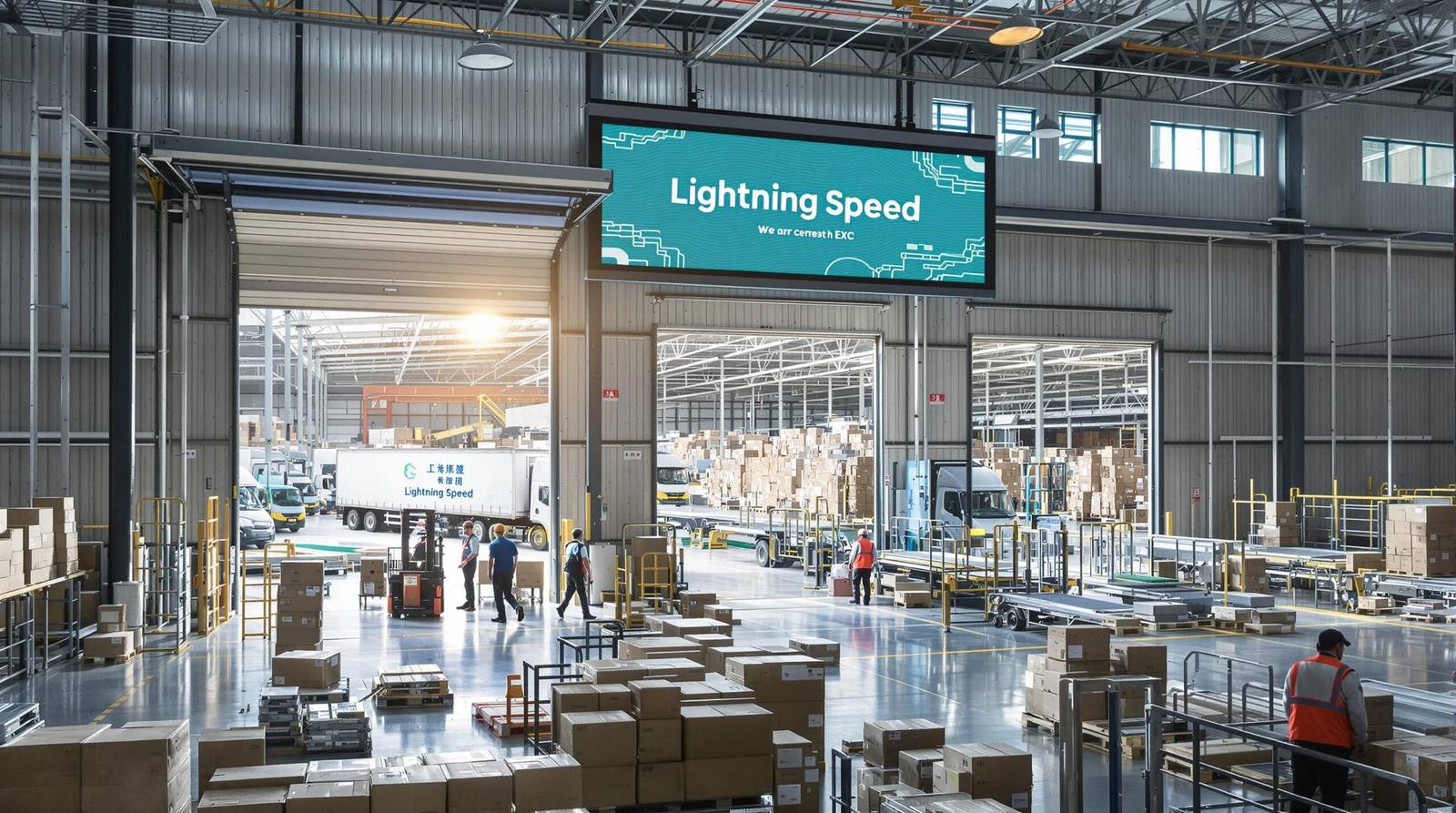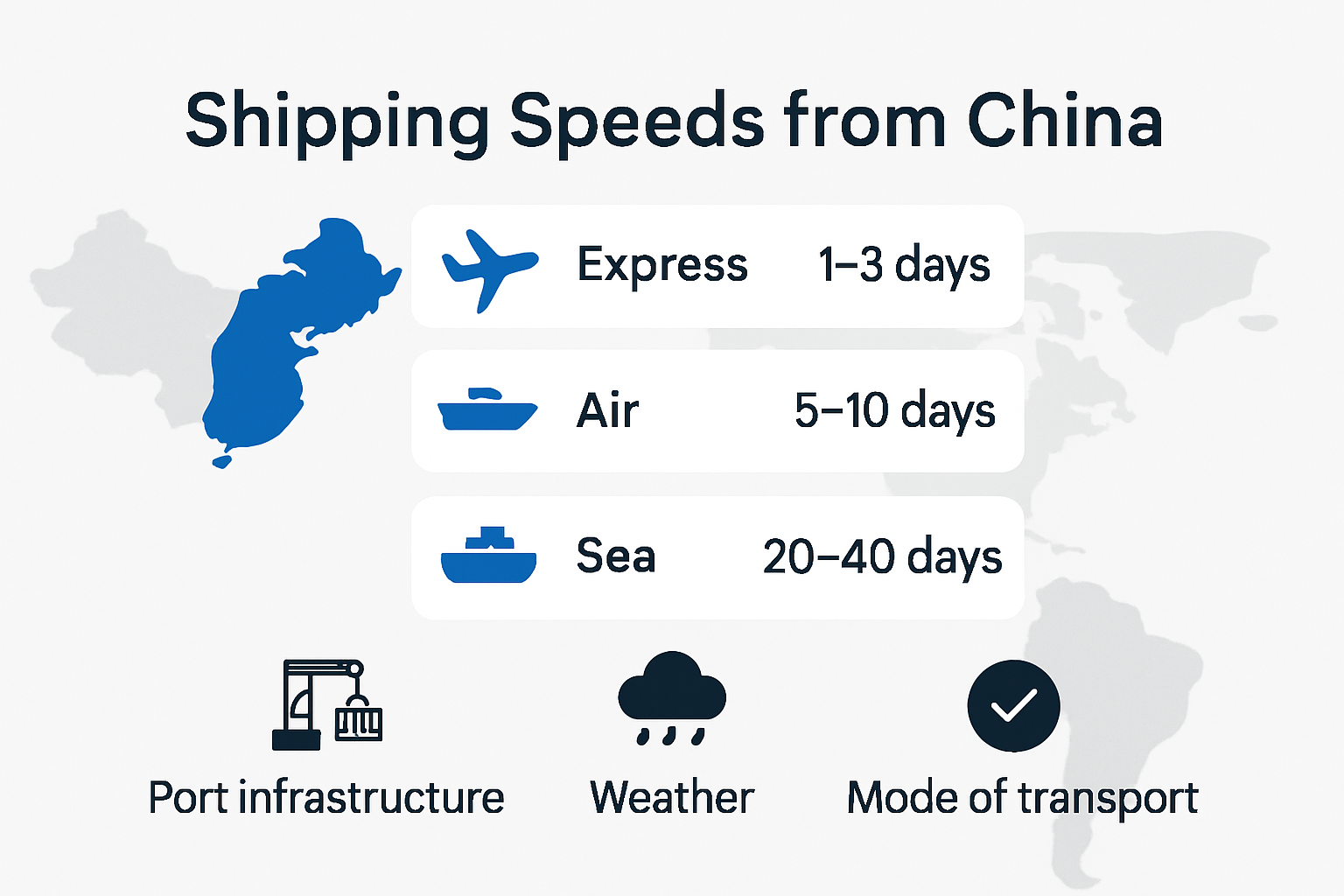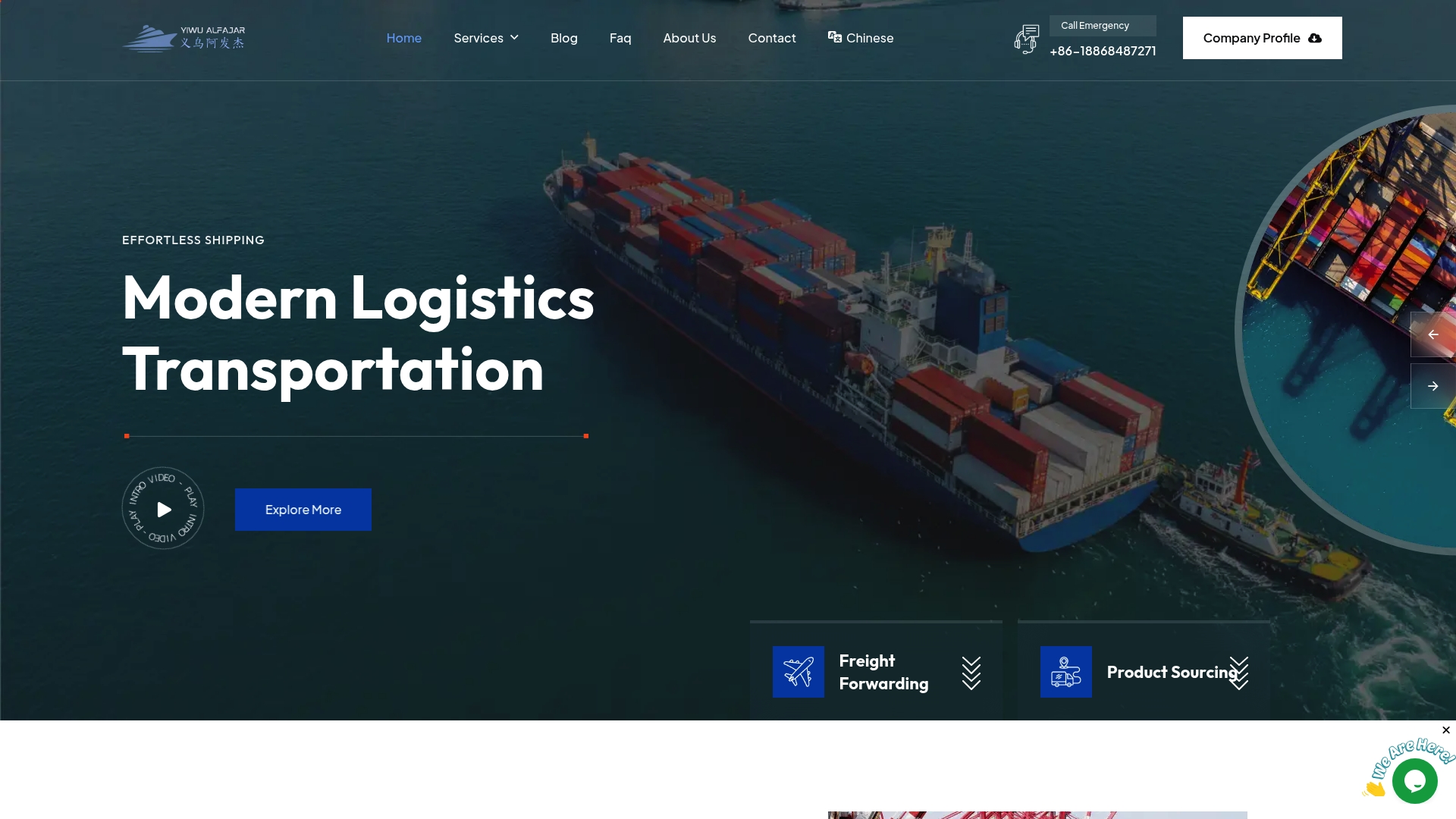
Getting packages from China delivered at lightning speed is no longer just a wish. Express shipping from China can get goods to the US in as little as 2 days, while sea freight might take up to 45. Most people think the fastest option is always the most expensive or only for big companies. The real surprise is that by picking the right route and mode, even small businesses can tap into jaw-dropping fast delivery without breaking the bank.
Table of Contents
- Key factors impacting shipping speed
- Express vs air vs sea freight options
- Tips for lowering transit time and costs
- Best shipping routes for usa, pakistan, and more
Quick Summary
| Takeaway | Explanation |
|---|---|
| Optimize your port and infrastructure selection | Assess port efficiency to minimize delays caused by congestion and equipment shortages. |
| Choose the right shipping mode based on urgency | Use express for urgent shipments, air freight for moderate speed, and sea freight for cost savings. |
| Consolidate shipments to reduce costs | Combining smaller shipments into larger ones can lower handling fees and improve negotiation leverage with carriers. |
| Stay informed on environmental factors | Awareness of seasonal changes and weather patterns can help in planning to avoid delays from disruptions. |
| Leverage alternative shipping routes | Explore emerging logistic corridors, like the Middle Corridor, to improve shipping efficiency and reduce costs. |
Key Factors Impacting Shipping Speed
Shipping from China involves a complex network of logistics challenges that directly influence delivery speed and reliability. Understanding these critical factors helps businesses optimize their international shipping strategies and set realistic expectations for transit times.

Infrastructure and Port Dynamics
Port infrastructure plays a pivotal role in determining shipping speed. Research from freight logistics experts reveals that port congestion has become a significant bottleneck in international shipping. Multiple interconnected elements contribute to potential delays, including:
- Equipment Availability: Shortage of shipping containers and handling equipment
- Labor Resources: Limited workforce and potential labor disruptions
- Technological Capabilities: Variations in port modernization and digital tracking systems
Businesses must recognize that these infrastructure challenges can add substantial time to shipping routes, potentially extending delivery windows by days or even weeks.
Environmental and Seasonal Considerations
Weather patterns substantially impact shipping timelines from China. Shipping route analysis indicates that typhoons and extreme weather conditions create significant disruptions. China experiences an average of 7 to 8 typhoons annually, which can dramatically alter shipping schedules and routes.
Key environmental factors affecting shipping speed include:
- Seasonal monsoon patterns
- Tropical storm seasons
- Temperature and humidity variations
- Potential maritime navigation restrictions
Understanding these environmental dynamics allows businesses to plan more effectively and build flexibility into their shipping strategies.
Transportation Mode Selection
The choice between air and ocean freight dramatically influences shipping speed. Comparative shipping data demonstrates significant variations in transit times:
- Air Freight: Typically 3 to 7 days
- Ocean Freight: Ranges from 15 to 40 days
Businesses must carefully evaluate their specific needs, balancing speed requirements against budget constraints. Learn more about selecting the optimal shipping method to maximize efficiency and cost-effectiveness.
Navigating these complex factors requires strategic planning, adaptability, and a deep understanding of global shipping dynamics. By anticipating potential challenges and selecting appropriate shipping solutions, businesses can minimize delays and optimize their international logistics performance.
Express vs Air vs Sea Freight Options
Choosing the right shipping method from China requires a strategic understanding of each transportation mode’s unique characteristics, advantages, and limitations. Businesses must carefully evaluate their specific needs to optimize logistics performance and cost-effectiveness.
Speed and Transit Time Comparisons
Shipping options from China vary dramatically in terms of delivery speed. Logistics research reveals distinct transit time differences across transportation modes:
- Express Shipping: 2-5 days
- Air Freight: 5-10 days
- Sea Freight: 20-45 days
Express shipping emerges as the fastest option, ideal for time-sensitive deliveries. Learn more about selecting the optimal shipping method to understand nuanced selection criteria.
Here is a table comparing delivery speed and typical use case for each main shipping mode:
| Shipping Mode | Typical Delivery Time | Best Use Case |
|---|---|---|
| Express Shipping | 2-5 days | Urgent, time-sensitive goods |
| Air Freight | 5-10 days | Moderate urgency, electronics |
| Sea Freight | 20-45 days | Large volume, cost-sensitive |
Economic and Volume Considerations
Recent industry analysis highlights significant shifts in global shipping dynamics. E-commerce trends, particularly from fast-fashion retailers, have dramatically reshaped air cargo capacity and pricing. Key economic factors include:
- Cargo space availability
- Fuel costs
- Global trade regulations
- Seasonal demand fluctuations
Businesses must balance speed requirements with budget constraints, recognizing that faster shipping methods typically command premium prices.
Emerging Logistics Trends
The international shipping landscape continues to evolve rapidly. Shipping industry reports indicate increasing complexity in cross-border logistics:
- Geopolitical tensions are reshaping trade routes
- E-commerce growth drives innovative shipping solutions
- Manufacturers seek alternative logistics strategies
Companies must remain adaptable, continuously reassessing their shipping strategies to maintain competitive advantage. The most successful businesses will leverage a flexible approach, potentially combining multiple shipping methods to optimize cost, speed, and reliability.
Navigating these options requires careful analysis of your specific business needs, product characteristics, and delivery expectations. By understanding the nuanced differences between express, air, and sea freight options, you can develop a robust shipping strategy that balances speed, cost, and operational efficiency.
Tips for Lowering Transit Time and Costs
Reducing shipping expenses and transit times requires strategic planning and sophisticated logistics management. Businesses importing from China can implement multiple approaches to optimize their international shipping performance and minimize financial burdens.
Strategic Shipping Consolidation

Logistics experts recommend consolidating smaller shipments into larger consignments as a critical cost-reduction strategy. This approach offers multiple advantages:
- Reduced Per-Unit Shipping Costs: Larger shipments distribute fixed expenses across more items
- Minimized Handling Fees: Fewer individual shipments mean lower processing expenses
- Improved Carrier Negotiations: Consistent volume attracts better pricing from logistics providers
Developing long-term relationships with specific carriers can lead to preferential rates and more reliable service. Explore our comprehensive guide on streamlining international shipping to understand advanced consolidation techniques.
Documentation and Customs Optimization
Shipping documentation research emphasizes the critical importance of accurate customs documentation. Precise paperwork can dramatically reduce potential delays and unexpected costs:
- Complete and accurate commercial invoices
- Precise harmonized tariff codes
- Comprehensive shipping manifests
- Detailed product descriptions
- Accurate declared value statements
Utilizing Full Container Load (FCL) shipping instead of Less than Container Load (LCL) can significantly reduce handling complexities and potential transit interruptions.
Below is a table summarizing key customs documentation and shipping type considerations:
| Documentation Type | Importance |
|---|---|
| Commercial Invoice | Establishes shipment value/details |
| Harmonized Tariff Code | Determines duties and regulations |
| Shipping Manifest | Lists cargo for tracking/clearing |
| Product Description | Ensures correct item classification |
| Declared Value Statement | Used for insurance/customs clearance |
| FCL vs LCL Choice | Affects speed and handling process |
Financial and Logistical Strategies
Freight forwarding insights reveal advanced techniques for minimizing shipping expenses:
- Negotiate comprehensive rates with freight forwarders
- Utilize bonded warehouses for deferred duty payments
- Implement just-in-time inventory management
- Explore alternative shipping routes and carriers
- Invest in technology for real-time shipment tracking
Successful international shipping requires a holistic approach that balances cost efficiency, speed, and reliability. By implementing these strategic recommendations, businesses can create a robust logistics framework that minimizes expenses while maintaining competitive delivery timelines.
Remember that continuous optimization and staying informed about global shipping trends are key to developing an adaptable and cost-effective international shipping strategy.
Best Shipping Routes for USA, Pakistan, and More
Navigating international shipping routes requires strategic understanding of global logistics networks, transportation modes, and regional complexities. Businesses seeking efficient shipping from China must consider multiple factors when selecting optimal routes for different destinations.
Transit Times and Route Considerations
Shipping logistics research reveals distinct transit characteristics for key destinations:
- USA Ocean Freight: 30 to 40 days
- Pakistan Ocean Freight: 10 to 20 days
- Air Freight to USA: 3 to 10 days
- Air Freight to Pakistan: 1 to 3 days
The choice of shipping route depends on critical variables including urgency, cargo volume, budget constraints, and specific destination requirements. Learn more about our DDP services for seamless international shipping to understand comprehensive logistics solutions.
Below is a table comparing transit times from China to key destinations by shipping mode:
| Destination | Shipping Mode | Typical Transit Time |
|---|---|---|
| USA | Ocean Freight | 30-40 days |
| USA | Air Freight | 3-10 days |
| Pakistan | Ocean Freight | 10-20 days |
| Pakistan | Air Freight | 1-3 days |
Alternative Maritime and Multimodal Routes
International transport analysis highlights emerging trade corridors that offer innovative shipping alternatives:
- Middle Corridor Route: Connects Southeast Asia and China to Europe via Kazakhstan, Caspian Sea, Azerbaijan, Georgia, and Turkey
- Northern Corridor: Traditional route through Russia
- Ocean Route: Traditional path via Suez Canal
The Middle Corridor has demonstrated significant potential, with cargo volume doubling to 1.5 million tons in 2022 while alternative routes experienced decline. This indicates a shifting landscape in global shipping strategies.
Regional Shipping Optimization
Comparative shipping data demonstrates the nuanced differences in shipping methods:
- Express services offer 1 to 5 day delivery
- Air freight provides faster transit with weight restrictions
- Sea freight remains cost-effective for large volumes
Businesses must carefully evaluate their specific requirements, considering factors such as:
- Shipment urgency
- Cargo characteristics
- Budget limitations
- Destination infrastructure
- Customs regulations
Successful international shipping demands flexibility, strategic planning, and a comprehensive understanding of global logistics networks. By analyzing route options, transit times, and transportation modes, businesses can develop robust shipping strategies that balance speed, cost, and reliability.
Remember that shipping routes are dynamic. Continuous monitoring of geopolitical developments, trade regulations, and emerging transportation corridors is essential for maintaining an adaptive and efficient international logistics approach.
Frequently Asked Questions
What is the fastest shipping option from China to the US?
Express shipping is the fastest option, allowing deliveries in as little as 2 to 5 days.
How long does air freight take compared to sea freight from China?
Air freight typically takes 5 to 10 days, while sea freight can range from 20 to 45 days, making air freight the quicker option.
What factors can impact shipping speed from China?
Key factors include port infrastructure, environmental conditions, transportation mode selection, and customs documentation accuracy.
How can I reduce shipping costs while maintaining fast delivery?
Consolidating shipments, optimizing documentation, and negotiating rates with carriers can help lower shipping costs while ensuring timely deliveries.
Unlock Speed and Certainty for Your Fastest China Shipments
Tired of unpredictable delays, confusing customs processes, and rising costs when shipping from China? As highlighted throughout this article, the struggle to balance transit time, accurate documentation, and smart route selection is real for businesses like yours. Uncertainty at ports, last-minute weather disruptions, and choosing between express, air, or sea freight can make your supply chain feel out of control. That is why YIWU AL FAJAR Shipping & Logistics has built solutions tailored for importers and exporters determined to never miss a critical deadline.

Ready to leave slow-moving shipments and red tape behind? Discover how our expert team can handle everything from FCL shipping and DDP logistics all the way to product sourcing and warehousing support. Visit our main site now to request your quote and take the stress out of international trade. Take control of your business growth today by exploring our proven global business logistics support and gain the speed and trust you need for 2025 and beyond.
Recommended
- Shipping Small Parcels from China to Pakistan & UAE: A Complete Guide
- The Best Way to Import from China: A Comprehensive Guide
- Product Sourcing from China: A Step-by-Step Guide – YIWU AL FAJAR Shipping & Logistics
- The Ultimate Guide to Yiwu Al Fajar Shipping: Connect Your Business Globally
- What Is Freight Forwarding? Guide for Modern Supply Chains 2025 – ORNER
- Speed vs. Personalization: How to Achieve Both in 2025

